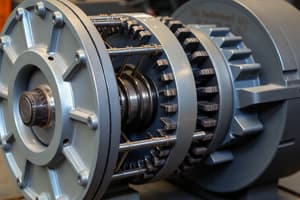Podcast
Questions and Answers
What role does the commutator play in a DC generator?
What role does the commutator play in a DC generator?
In a singly excited magnetic field system, what primarily determines the magnetic force?
In a singly excited magnetic field system, what primarily determines the magnetic force?
What phenomenon occurs when a generator fails to self-excite?
What phenomenon occurs when a generator fails to self-excite?
What is the effect of armature reaction in a DC generator?
What is the effect of armature reaction in a DC generator?
Signup and view all the answers
What is the purpose of an equalizer bar in parallel operation of DC generators?
What is the purpose of an equalizer bar in parallel operation of DC generators?
Signup and view all the answers
Which method of excitation in DC generators can operate without external power sources?
Which method of excitation in DC generators can operate without external power sources?
Signup and view all the answers
What is the primary purpose of using laminated armatures in DC generators?
What is the primary purpose of using laminated armatures in DC generators?
Signup and view all the answers
Which characteristic does not describe the load characteristics of shunt generators?
Which characteristic does not describe the load characteristics of shunt generators?
Signup and view all the answers
What is a corrective action to address failure in self-excitation of a DC generator?
What is a corrective action to address failure in self-excitation of a DC generator?
Signup and view all the answers
What is the role of compensating windings in a DC generator?
What is the role of compensating windings in a DC generator?
Signup and view all the answers
Flashcards
Electromechanical Energy Conversion
Electromechanical Energy Conversion
The process of converting electrical energy into mechanical energy or vice versa using magnetic fields.
Force in a Magnetic Field
Force in a Magnetic Field
The force exerted on a conductor carrying current in a magnetic field. It can be calculated using the equation F = ILB*sin(theta), where F is the force, I is the current, L is the length of the conductor, B is the magnetic field strength, and theta is the angle between the current and magnetic field.
Magnetic Energy
Magnetic Energy
The energy stored in a magnetic field system due to the magnetic flux density and the current flowing in the coils. It can be calculated using the equation W = 1/2LI^2, where W is the energy, L is the inductance, and I is the current.
DC Generator
DC Generator
Signup and view all the flashcards
Parallel Operation of DC Generators
Parallel Operation of DC Generators
Signup and view all the flashcards
Coenergy Method
Coenergy Method
Signup and view all the flashcards
Shunt Generator
Shunt Generator
Signup and view all the flashcards
Series Windings
Series Windings
Signup and view all the flashcards
Study Notes
Electromechanical Energy Conversion
- Energy balance, energy and force in singly excited magnetic field systems, determination of magnetic force, coenergy, and multi-excited magnetic field systems are crucial concepts.
DC Generators
- DC generators convert mechanical energy into electrical energy.
- The commutator reverses the direction of current in the armature windings, providing unidirectional output.
- Key components include the stator, rotor, field windings, and armature windings.
- Armature windings include lap windings and wave windings, with simplex and multiplex variations.
- Laminated armature minimizes eddy current losses.
- Generated voltage is related to speed, magnetic flux, and number of conductors (EMF Equation).
- Separately excited and self-excited generators are discussed.
- The process of achieving the initial voltage is known as EMF build-up.
- Critical field resistance and critical speed are essential for self-excitation.
- Causes for failure to self-excite and remedial measures are important considerations.
- Armature reaction (cross-magnetizing and demagnetizing ampere-turns per pole) affects output voltage.
- Compensating windings reduce armature reaction effects.
- Commutation is the process of efficiently changing current direction in the armature.
- Reactance voltage can disrupt commutation.
- Various techniques improve commutation.
- Shunt, series, and compound generator load characteristics are examined.
- Parallel operation of DC generators is discussed.
- Equalizer bars and cross connections of field windings ensure equal load sharing among parallel generators.
Studying That Suits You
Use AI to generate personalized quizzes and flashcards to suit your learning preferences.
Description
This quiz explores the principles of electromechanical energy conversion and the operation of DC generators. Key topics include forces and torques in magnetic fields, commutator action, and constructional features of generators. Understand the EMF equation and various methods of excitation used in these systems.




